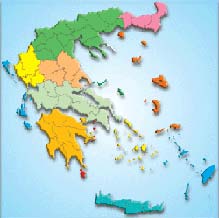
Please click on the map,
the region you want to visit |
|
|
|
|
| |
|
 |
Τhe Square of the Cathedral in Naxos |
|
 In this area, important relics of the past of Naxos town, from the 2nd and 1st millennium BC, have been revealed. At the specially designed area above the square, one can see parts of a tomb, where the ancients venerated their ancestors - builders of their city and the ruins of the walls of a prehistoric settlement. Both occurred as a main reference to the history of the place in front of market area of the city. The area had preserved its central importance and during the Christian era. In this area, important relics of the past of Naxos town, from the 2nd and 1st millennium BC, have been revealed. At the specially designed area above the square, one can see parts of a tomb, where the ancients venerated their ancestors - builders of their city and the ruins of the walls of a prehistoric settlement. Both occurred as a main reference to the history of the place in front of market area of the city. The area had preserved its central importance and during the Christian era.
Typical is the strong presence of Christian worship in it: |

- On the east stands the cathedral of Life Giving (1), built in 1787 by Bishop Neophytos on the place of an older small temple.
- On the west is the cluster of Our Lady of Chrysopolitissa (2), consisting of four basilicas together, built at different times: The oldest, the protector of Naxos, Chrysopolitissa, known also as the Great Theologian, testified by the early of 17th century. The other aisles are dedicated to Holy Apostles to St. Spyridon and St. Charalambos.
- On the south is the two-aisled church of Panagia Eleousa (3), also known as Theologian, which also is testified from the 17th century.
- On the north, in the free space, where there is now a shrine, it is said Metropolis was there, the church of Annunciation (4).
- On the square, in front of the cathedral, is the church of St. Nicholas (5). The maintenance of the floor on the level of the ancient ruins of the 4th-7th AD century (the access, before the development of the housing of the ancient ruins and the corrosion of the soil was done by a descent ladder) reveals a long history of the cult of saints in this place.
|
In the covered-sheltered room which you can see on the square of the Cathedral, a visible part from the eastern wall of the Mycenaean city of Naxos has been retained (13th-11th century BC).
The wall was probably descending from the hill of the castle to the sea and enclosed an extensive village of urban character.
The building, with stone base and mud bricks by clay at the superstructure, has a thickness of 3.10 m.
On the left, the damaged facade of the wall has been partially rebuilt to indicate clearly its structure.
  In the area of the north coast of Naxos Town (Grotta) and on Palatia Island, there are many remnants from the continuous human presence from the Neolithic period (fifth millennium BC) until today. (1-2) In the area of the north coast of Naxos Town (Grotta) and on Palatia Island, there are many remnants from the continuous human presence from the Neolithic period (fifth millennium BC) until today. (1-2)
 The part of the Mycenaean city that is preserved in Cathedral square, shows that Naxos was already developed, in the 13th-11th century, as an urban center (3). The remains of the next phase in this area belong to a tomb, formed during the early historic period, and document a persistent historical memory of local residents. The part of the Mycenaean city that is preserved in Cathedral square, shows that Naxos was already developed, in the 13th-11th century, as an urban center (3). The remains of the next phase in this area belong to a tomb, formed during the early historic period, and document a persistent historical memory of local residents.
At the end of the Mycenaean period, the coastal part of the city was deserted, because there was no safety from the sea. The residents buried important dead people, in the ruins that they felt as their ancestral home, and they worshiped them as ancestor heroes for over 1000 years (9th BC - 1st century AD.) in the same place, beside the market of the classical city, which was spread again over the beach. In later Roman times, private houses covered the

venerable area.
The importance and the conservation of the remains, and the needs of
the modern life, were the criteria by which the ruins were visible protected inside the indoor space or in the ground around it (4).
The project was done by the help of the Programmatic Agreement of the Ministry of Culture, Archaeological Resources Association and the Municipality of Naxos
|
|
Source: 11' Prehistoric and Classical Antiquities Association
|
 |
Accommodation and Entertainment proposals in Naxos |
|
|
|